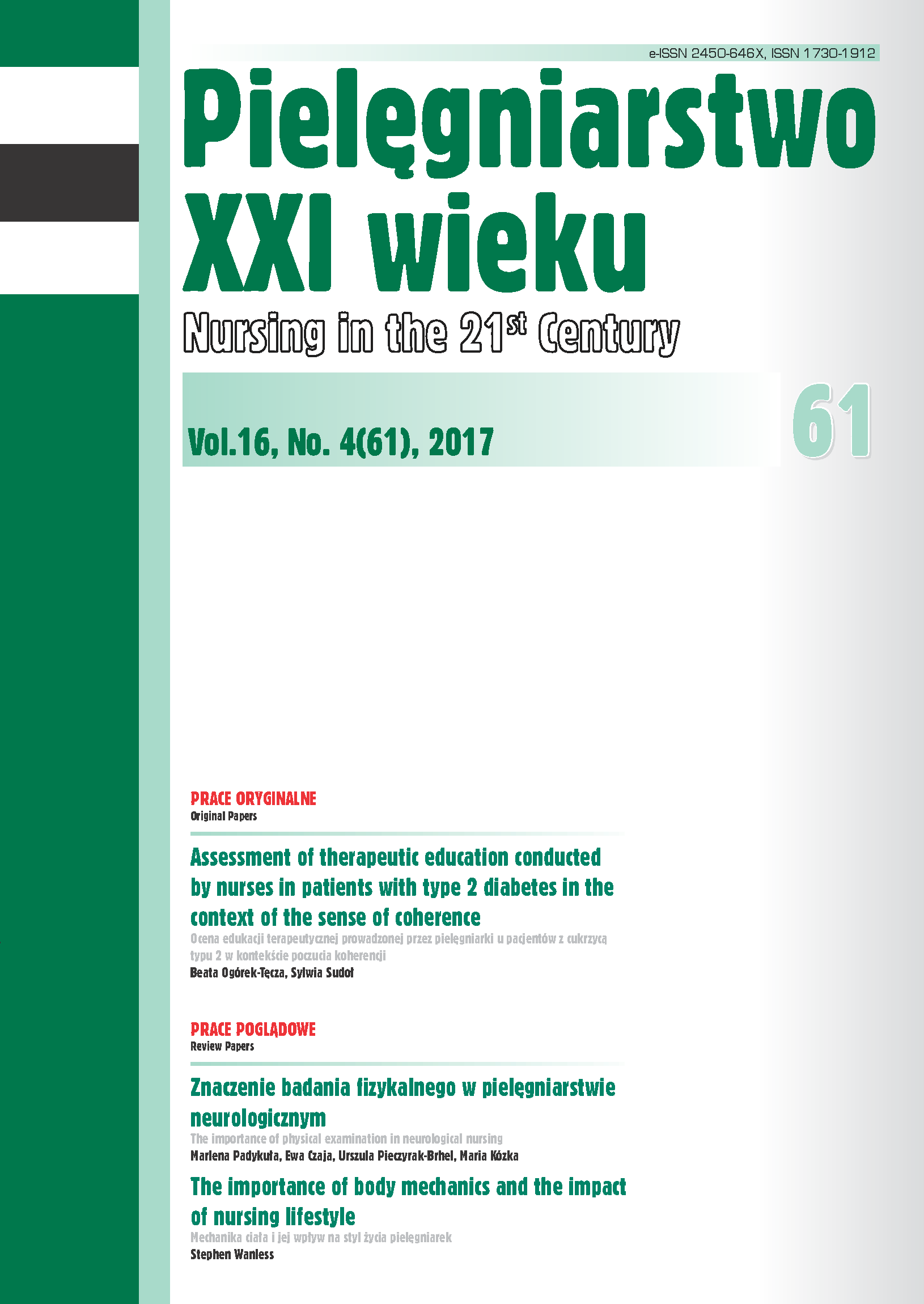The importance of body mechanics and the impact of nursing lifestyle
DOI:
https://doi.org/10.1515/pielxxiw-2017-0038Keywords:
body mechanics, moving and handling practice, lifestyle changeAbstract
THE IMPORTANCE OF BODY MECHANICS AND THE IMPACT OF NURSING LIFESTYLE
Nursing staff experience more low back pain than many other groups, the incidence varies among countries. Work activities involving bending, twisting, frequent heavy lifting, awkward static posture and psychological stress are regarded as causal factors for many back injuries. Preventive measures should be taken to reduce the risk of lower back pain, such as arranging proper rest periods, educational programmes to teach the proper use of body mechanics and lifestyle change programmes.
References
1. Cheung KMC. The relationship between disc degeneration, low back pain, and human pain genetics. The Spine Journal. 2010;10 (11) : 958-960.
2. June KJ, Cho S. Low back pain and work-related factors among nurses in intensive care units. Journal of Clinical Nursing. 2011; 20 (3): 479-487.
3. Castro AB. Handle with Care: The American Nurses Association’s Campaign to Address Work-Related Musculoskeletal Disorders. Orthopaedic Nursing. 2006; 25 (6): 356-365.
4. de Souza Petersen R, Marziale MHP. Low back pain characterized by muscle resistance and occupational factors associated with nursing. Revista Latino-Americana de Enfermagem. 2014; 22 (3): 386-393.
5. Lind A, Gard G. Harmful Effects in Personal Assistants Client Transfer Situations. The Ergonomics Open Journal. 2014; 7: 1-5.
6. Bonzini M, Bertu L, Veronesi, G, et al. Is musculoskeletal pain a consequence or a cause of occupational stress? A longitudinal study. International Archives of Occupational and Environmental Health. 2015; 88 (5): 607-612.
7. Wanless S. Improving the effectiveness of motor skills learning in moving and handling training for the healthcare environment. Unpublished PhD thesis, 2015.
8. Waters TR, Dick RB. Evidence of Health Risks Associated with Prolonged Standing at Work and Intervention Effectiveness. Rehabilitation Nursing. 2014; 40 (3): 148-165.
9. Bevan S. Economic impact of musculoskeletal disorders (MSDs) on work in Europe. Best Practice & Research Clinical Rheumatology. 2015; 29 (3): 356-373.
10. Parent-Thirion A. Vermeylen G, van Houten G, et al. Eurofound project: Fifth European Working Conditions Survey. The European Foundation for the Improvement of Living and Working Conditions. Luxembourg, 2012.
11. Ng D, McNee C, Kieser K, Farella M. Neck and shoulder muscle activity during standardized work-related postural tasks. Applied Ergonomics. 2014; 45 (3): 556-563.
12. Smedley J, Williams S, D’Arcy P, et al. Back pain management: Occupational health practice in the NHS in England. A national clinical audit – round 2. Royal College of Physicians. London, 2012.
13. Boorman S. NHS Health and Well-being – Final Report. Dept of Health, London, 2009.
14. Health & Safety Executive. Work related Musculoskeletal Disorders (WRMSDs) Statistics in Great Britain 2017. HMSO. London, 2017.
15. Wanless S. Principles for the Safe Moving and Handling of Patients. Nursing in the 21st Century. 2017; 15 (4): 66-69.
16. Thomas JR, Nelson JK, Silverman SJ. Research Methods in Physical Activity, 7th Ed. Champaign, IL. Human Kinematics, 2015.
17. Karimi MT, Solomonidis S. The relationship between parameters of static and dynamic stability tests. Journal of Research in Medical Sciences. 2011; 16 (4): 530-535.
18. Patel K. Complete Guide to Postural Training. London. Bloomsbury Ltd, 2014.
19. Bond M. The New Rules of Posture: How to sit, stand and move. Rochester. Healing Arts Press, 2007.
20. Dangerfield P. Chapter 4: Assessment of posture. In Eston, R. Riley, T. (Eds) (2009) Kinanthropometry and Exercise Physiology Laboratory Manual: Tests, Procedures and data, third Edition, Volume one: Anthropometry. London; Routledge, 2009.
21. Hirshkowitz M, Whiton K, Albert SM, et al. National Sleep Foundation’s sleep time duration recommendations: methodology and results summary. Sleep Health. 2015; 1 (1): 40-43.
Published
Issue
Section
License
Copyright (c) 2017 Author

This work is licensed under a Creative Commons Attribution-NonCommercial-NoDerivatives 3.0 Unported License.




